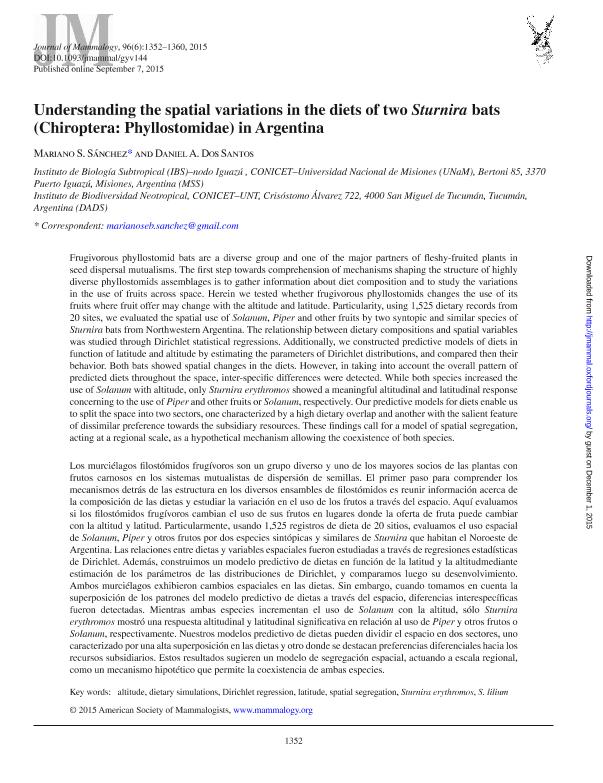Mostrar el registro sencillo del ítem
dc.contributor.author
Sanchez, Mariano Sebastian

dc.contributor.author
Dos Santos, Daniel Andrés

dc.date.available
2017-02-14T22:06:05Z
dc.date.issued
2015-12
dc.identifier.citation
Sanchez, Mariano Sebastian; Dos Santos, Daniel Andrés; Understanding the spatial variations in the diets of two Sturnira bats (Chiroptera: Phyllostomidae) in Argentina; Oxford University Press; Journal Of Mammalogy; 96; 6; 12-2015; 1352-1360
dc.identifier.issn
0022-2372
dc.identifier.uri
http://hdl.handle.net/11336/13044
dc.description.abstract
Frugivorous phyllostomid bats are a diverse group and one of the major partners of fleshy-fruited plants in seed dispersal mutualisms. The first step towards comprehension of mechanisms shaping the structure of highly diverse phyllostomids assemblages is to gather information about diet composition and to study the variations in the use of fruits across space. Herein we tested whether frugivorous phyllostomids changes the use of its fruits where fruit offer may change with the altitude and latitude. Particularity, using 1,525 dietary records from 20 sites, we evaluated the spatial use of Solanum, Piper and other fruits by two syntopic and similar species of Sturnira bats from Northwestern Argentina. The relationship between dietary compositions and spatial variables was studied through Dirichlet statistical regressions. Additionally, we constructed predictive models of diets in function of latitude and altitude by estimating the parameters of Dirichlet distributions, and compared then their behavior. Both bats showed spatial changes in the diets. However, in taking into account the overall pattern of predicted diets throughout the space, inter-specific differences were detected. While both species increased the use of Solanum with altitude, only Sturnira erythromos showed a meaningful altitudinal and latitudinal response concerning to the use of Piper and other fruits or Solanum, respectively. Our predictive models for diets enable us to split the space into two sectors, one characterized by a high dietary overlap and another with the salient feature of dissimilar preference towards the subsidiary resources. These findings call for a model of spatial segregation, acting at a regional scale, as a hypothetical mechanism allowing the coexistence of both species.
dc.description.abstract
Los murciélagos filostómidos frugívoros son un grupo diverso y uno de los mayores socios de las plantas con frutos carnosos en los sistemas mutualistas de dispersión de semillas. El primer paso para comprender los mecanismos detrás de las estructura en los diversos ensambles de filostómidos es reunir información acerca de la composición de las dietas y estudiar la variación en el uso de los frutos a través del espacio. Aquí evaluamos si los filostómidos frugívoros cambian el uso de sus frutos en lugares donde la oferta de fruta puede cambiar con la altitud y latitud. Particularmente, usando 1,525 registros de dieta de 20 sitios, evaluamos el uso espacial de Solanum, Piper y otros frutos por dos especies sintópicas y similares de Sturnira que habitan el Noroeste de Argentina. Las relaciones entre dietas y variables espaciales fueron estudiadas a través de regresiones estadísticas de Dirichlet. Además, construimos un modelo predictivo de dietas en función de la latitud y la altitudmediante estimación de los parámetros de las distribuciones de Dirichlet, y comparamos luego su desenvolvimiento. Ambos murciélagos exhibieron cambios espaciales en las dietas. Sin embargo, cuando tomamos en cuenta la superposición de los patrones del modelo predictivo de dietas a través del espacio, diferencias interespecíficas fueron detectadas. Mientras ambas especies incrementan el uso de Solanum con la altitud, sólo Sturnira erythromos mostró una respuesta altitudinal y latitudinal significativa en relación al uso de Piper y otros frutos o Solanum, respectivamente. Nuestros modelos predictivo de dietas pueden dividir el espacio en dos sectores, uno caracterizado por una alta superposición en las dietas y otro donde se destacan preferencias diferenciales hacia los recursos subsidiarios. Estos resultados sugieren un modelo de segregación espacial, actuando a escala regional, como un mecanismo hipotético que permite la coexistencia de ambas especies.
dc.format
application/pdf
dc.language.iso
eng
dc.publisher
Oxford University Press

dc.rights
info:eu-repo/semantics/openAccess
dc.rights.uri
https://creativecommons.org/licenses/by-nc-sa/2.5/ar/
dc.subject
Altitude
dc.subject
Dietary Simulations
dc.subject
Dirichlet Regression
dc.subject
Latitude
dc.subject
Spatial Segregation
dc.subject
Sturnira Erythromos
dc.subject
S. Lilium
dc.subject.classification
Ecología

dc.subject.classification
Ciencias Biológicas

dc.subject.classification
CIENCIAS NATURALES Y EXACTAS

dc.title
Understanding the spatial variations in the diets of two Sturnira bats (Chiroptera: Phyllostomidae) in Argentina
dc.type
info:eu-repo/semantics/article
dc.type
info:ar-repo/semantics/artículo
dc.type
info:eu-repo/semantics/publishedVersion
dc.date.updated
2017-02-13T20:31:35Z
dc.identifier.eissn
1545-1542
dc.journal.volume
96
dc.journal.number
6
dc.journal.pagination
1352-1360
dc.journal.pais
Reino Unido

dc.journal.ciudad
Oxford
dc.description.fil
Fil: Sanchez, Mariano Sebastian. Universidad Nacional de Tucuman. Facultad de Cs.naturales e Instituto Miguel Lillo. Instituto de Biodiversidad Neotropical; Argentina. Consejo Nacional de Investigaciones Científicas y Técnicas. Centro Científico Tecnológico Tucumán; Argentina
dc.description.fil
Fil: Dos Santos, Daniel Andrés. Consejo Nacional de Investigaciones Cientificas y Tecnicas. Centro Cientifico Tecnologico Nordeste. Instituto de Biologia Subtropical. Instituto de Biologia Subtropical - Nodo Puerto Iguazu; Argentina. Universidad Nacional de Misiones; Argentina
dc.journal.title
Journal Of Mammalogy

dc.relation.alternativeid
info:eu-repo/semantics/altIdentifier/doi/http://dx.doi.org/10.1093/jmammal/gyv144
dc.relation.alternativeid
info:eu-repo/semantics/altIdentifier/url/https://academic.oup.com/jmammal/article-lookup/doi/10.1093/jmammal/gyv144
Archivos asociados
